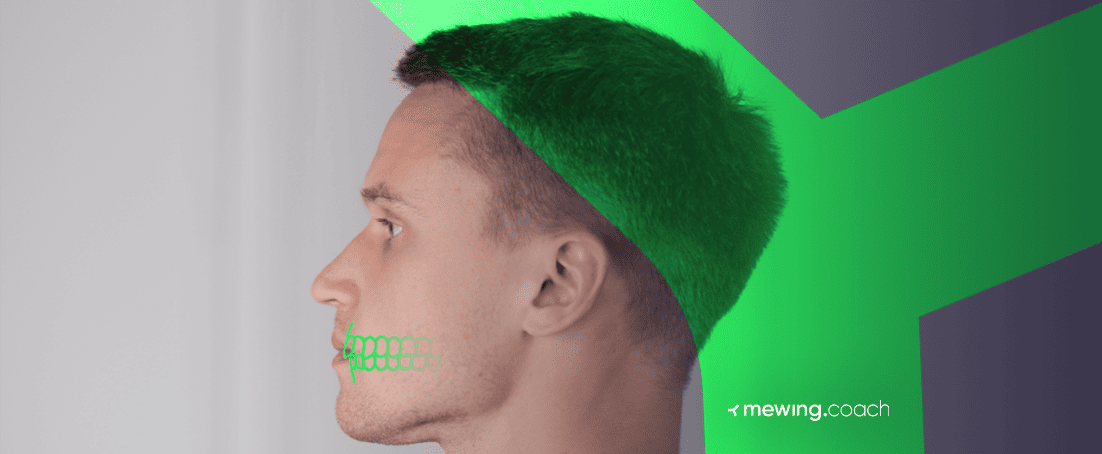Do you want to have a million-dollar smile to match your bright personality?
Of course, you do. Everyone does. And mewing is here to help you get your teeth in line with a few simple exercises.
🔎 Revealed on this page:
- 📖 How to help straighten teeth with the mewing method.
- 📝 All your queries about mewing and straightening teeth answered.
- 💪 How mewing can benefit you.
Let’s get things straight!

What Should You Know about Mewing?
Mewing and orthotropics is a method that teaches correct tongue posture, introduced by British orthodontists John and Mike Mew. It helps to improve oral health and resolve certain aesthetic concerns.
The mewing impact on face features and its health benefits are significant if the person starts doing the exercises at an early age and correctly.
Proponents of the method usually start mewing for aesthetic reasons – to improve their jawline and general facial appearance. Anecdotally, people who’ve adopted an everyday mewing habit and completely changed their tongue positioning have achieved a transformation in their looks.
By teaching patients to lift the posterior third part of the tongue and press it on the roof of the mouth, mewing has helped them relieve sleep apnea symptoms, mouth breathing, receding chin, and TMJ disorder symptoms.
The correct way to do mewing?
So, how to do mewing correctly? For maximum results, place the whole tongue on the top of the mouth and keep the teeth in a resting position. Correct mewing also means learning how to rest your teeth and avoid contact between them to prevent problems with malocclusion and crooked teeth in the long run.
Is Mewing Good for Your Teeth?
Definitely!
Mewing tackles issues connected to misaligned teeth and a bad bite. The right way to place your tongue when mewing helps align the lower jaw with your upper jaw, consequently resolving problems with malocclusion.
If the exercises are done correctly from the start – especially from an early age or adolescence – they help improve facial structure, which also involves crooked teeth.
Can Mewing Be Bad for Your Teeth?
Absolutely not. Mewing does not cause any damage to your teeth. On the contrary, it helps preserve your dental health by teaching you the correct teeth posture.
How Are Teeth Supposed to Sit When Mewing Correctly?
Let’s learn how teeth should sit correctly when mewing. The technique requires that teeth are placed in a resting position. Resting teeth are not involved in actions such as chewing or talking and are held slightly apart.
The teeth are not supposed to touch each other when mewing. Your upper teeth should slightly overlap the lower teeth with less than an inch of space between them. This is done to avoid clashing, chipping, and other tooth damage.
Can Mewing Help Straighten Crooked Teeth?
There is still no scientific evidence that mewing helps straighten crooked teeth. It’s more of a preventive measure or complementary exercise to other orthodontic treatments.
The technique does not involve pulling teeth into place and is therefore not directly connected to teeth straightening. However, learning how to position all the organs in the mouth properly can help treat crooked teeth.
There is anecdotal evidence that these exercises have helped expand the palate, improving the shape of the dental arch. But it takes years to see if mewing actually works in improving the facial structure and eventually helping straighten your teeth.
What Is the Connection Between Mewing and Teeth Straightening?
Crooked teeth are closely connected to jaw size and alignment. Well-proportioned and aligned jaws have more space for growth and prevent crowded teeth.
Smaller jaws allow too little space for teeth growth, which leads to crooked and misaligned teeth. The Tropic Premise states that this occurs as a direct consequence of eating too many processed foods that are too soft and not engaging the teeth and jaws in the process of chewing.
People who have chewed hard foods since a very young age have forward facial growth – bigger jaws and well-aligned teeth. The mewing technique can help with palatal expansion and creating space for crooked teeth.
Also, issues with misaligned teeth appear because of bad habits in infancy, including thumb sucking and pacifier use. They cause deformation of the palate, which can lead to crooked teeth.
How Not to Do Mewing
So, how not to do mewing? It is important to avoid any mewing mistakes that can result in jaw issues and further damage to your teeth. Be mindful of the right position of your teeth and tongue, and practice correct body posture.
Orthodontic Treatment for Crooked Teeth
Your orthodontist can suggest methods of straightening teeth with different devices and devise a treatment plan that considers other factors related to your health.
Below, we’ll look at how orthodontics helps straighten teeth:
Metal Braces
Fixed metal braces are attached to the teeth with brackets, flexible wire, and bands. They are the go-to treatment for cases of complex misalignment and crooked teeth.
Lingual Braces
Lingual braces are positioned on the back of the teeth and are invisible. They are perfect for image-conscious teenagers or working professionals who do not want to attract attention to their dental treatment.
Invisible Braces
Invisible braces are made of clear plastic, making them nearly invisible, and are meant for teenagers and adults only. They are custom-made to fit your crooked teeth and are removed and replaced twice a month.
Conclusion
Do you wish to improve the appearance of your crooked teeth? Well, teeth straightening is best done when combining mewing (exercising of the facial muscles) and orthodontic practices (such as braces).
By doing mewing regularly, you’ll align your jaws, which, in turn, will help straighten teeth – but only if you start right away!





